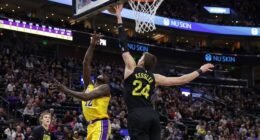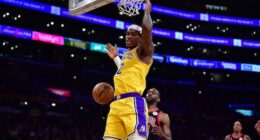The 1990’s were nowhere near as successful for the Lakers as were its surrounding years. Between the 1990 and 1999 NBA seasons, the Lakers went through six different head coaches. It wasn’t until the summer before the 1999-2000 season that they found the gem they had been searching for.
The man called upon was none other than Phil Jackson. The former player and current Zen Master, had found his niche as a coach with the Chicago Bulls during the 90’s and had led them to six championships in eight years, as well as the historic 72-win season that has yet to be touched.
With the talent and skill of Shaquille O’Neal and Kobe Bryant already in place, as well as a strong supporting cast of proven veterans, Jackson was viewed as the final piece to the teams championship puzzle. Despite being ladened with high expectations, Jackson was once again able to come through victorious, guiding the Lakers to three titles in as many seasons through his usage of the Triangle Offense.
However, after two unforeseen seasons of early playoff exits, the Lakers and Phil Jackson severed ties, and went there separate ways. The Lakers brought in Rudy Tomjanovich, a coach with championship rings to show, but for some reason, seeing him on the sidelines just didn’t feel right. He was running a run and gun offense, which was quite different from the Triangle and 43 games into the 2004-2005 NBA season (his first with the Lakers), he resigned from his post as head coach, and assistant coach, Frank Hamblen finished out the season (with the team running the triangle offense of course).
Hamblen made it known he did not want to be the head coach of a team and was content with being an assistant. After only one year away from the game, Phil Jackson agreed to come back and signed on with the team, despite it’s below average roster. After two years of first round exits, the Lakers slowly started to make their way back on top. By the end of the 2008 season, the Lakers were finally atop the Western Conference and the favorites to reach the NBA Finals. However, their long-time rival Boston Celtics would send them home in embarrassing fashion, winning the deciding game by 39 points.
Determined to win Phil his 10th NBA championship, which would give him more championship rings than any other coach in the game’s history, the Lakers came back in 2009 on a mission, and didn’t stop until they were celebrating on Orlando’s home court after capturing the franchise’s 15th title. In 2010, it was the same story, but with a different wrinkle. Ron Artest, a league-wide known enigma replaced Trevor Ariza on the roster, and everyone was looking at Phil to do with Artest what he had previously done with former head-case, Dennis Rodman. Although he had his share of speed bumps, Artest came up big in the Lakers 2010 playoff run, and was a key contributor in the Lakers game 7 finals win over Boston. Once again, Phil had succeeded. Coming back for his 21st and final season, Phil is looking to capture his 12th title. If he does so, I think it’s safe to making him apart of Lakers culture has been one of the greatest moves this franchise has ever made, as it has resulted in five banners hanging in Staples Center.
Next: The Captain








